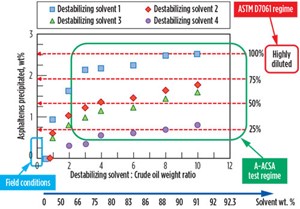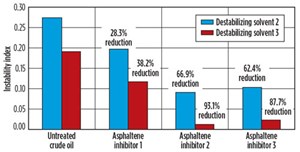Asphaltene stability analysis facilitates deepwater treatment optimization
Asphaltenes, which are defined by IP 143/90, are the components in petroleum that are insoluble when contacted with a large excess of aliphatic solvent, such as heptane and pentane.1 The components precipitated and defined as asphaltenes are comprised of a distribution of tens of thousands of chemical species that vary from one crude oil to the next. Despite being defined by a solubility separation procedure—not chemical structure—numerous chemical similarities exist within the thousands of chemical species defined as asphaltenes.
Asphaltenes are a highly aromatic species, typically containing several polynuclear aromatic rings; they also have a significant aliphatic content, particularly from alkyl side chains. Asphaltenes are some of the higher molecular weight species present in crude oil. A large percentage of the heteroatoms (N, S and O) present within crude oil, and the majority of metals (Ni and V), are associated with asphaltene structures.
Asphaltenes are a concern in both the production and refining of hydrocarbons. In production, asphaltenes are a concern if thermodynamic instability occurs, causing precipitation and subsequent deposition or fluid processing problems. Fortunately, the majority of crude oils do not experience asphaltene deposition problems during production. The occurrence of asphaltene deposition depends on the chemistry of the specific crude oil, the production system configuration/design, and the operating conditions therein.
For some production systems, actual operations can create problems. For example, CO2 flooding almost universally induces asphaltene precipitation and, subsequently, potential deposition problems.
Asphaltene deposition can be devastating for a deepwater field’s economics. The cost of deepwater subsea production systems, the potential for immense output losses, and the difficulties and expense of remediating deposition in subsea systems, make it imperative that all deepwater fields are evaluated for asphaltene concerns. If concerns exist, effective prevention treatments must be designed for the success of
the field.
In a system operating without artificial lift, only the more insoluble asphaltenes precipitate, which are a fraction of the total asphaltene content and have chemical differences from other asphaltenes within the total distribution.2,3,4 The attempt to recreate field conditions in the laboratory requires the use of high-pressure testing with the specific samples of live crude oil, or, less optimally, using recombined and reconditioned versions of the live crude oil. High-pressure testing requires specialized equipment, and it is not an easy undertaking. Furthermore, live fluid samples are expensive and difficult to obtain, and, consequently, they are often unavailable for testing. Despite these efforts, laboratory live fluid testing does not fully recreate the exact, complex, multiphase flow characteristics present in actual production systems. Therefore, having easier, more reliable methods to evaluate asphaltene stability, and asphaltene inhibitor performance, with dead crude oil samples is desirable.
Working with dead crude oils requires an artificial method to destabilize asphaltenes, commonly via a dilution with destabilizing solvent, such as aliphatic fluids like heptane and pentane. The amount of asphaltene precipitation, and the destabilized asphaltene chemistry, can be altered with the choice of destabilizing solvent and the destabilizing solvent/crude oil mixture ratio used. This approach was used previously to separate different amounts of asphaltenes, with varying chemistry differences, from Canadian bitumens.5,6 Through proper choice of test conditions, a dead crude oil test method can be developed, which is closer to field conditions, in that it destabilizes only the more insoluble asphaltenes.
In this article, various asphaltene testing methods will be reviewed, but more focus will be given to a new method, which utilizes an analytical centrifuge to evaluate the stability of asphaltenes. This method simultaneously subjects a crude oil to a solvent that destabilizes asphaltenes and centrifugal force; it has been named Asphaltene-Analytical Centrifuge Stability Analysis—Asphaltene-ACSA or A-ACSA for short. The method can be used to evaluate the relative performance of asphaltene inhibitors and field-monitoring programs. The destabilizing solvent procedure used in the Asphaltene–ACSA method has been selected to work with much higher crude oil concentrations and to destabilize a much smaller fraction of the asphaltene distribution (in comparison to some other dead-crude oil methods) to move test conditions closer to actual field conditions.
ASPHALTENE EVALUATION METHODS
For onshore and even shallow-water production, assessment of asphaltene deposition risk is not as critical, due to the lower economic impact and easier ability to remediate. For deepwater fields, however, it is imperative that an exacting evaluation be made.
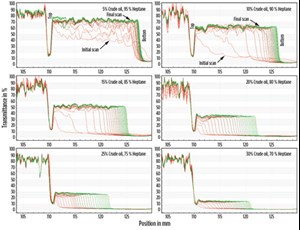
The initial testing performed generally determines whether any asphaltene instability exists and, if so, measure the asphaltene onset pressure. Various methods have been developed to measure asphaltene onset pressures, including: electrical conductance;7 filtration/phase sampling and analysis;8,9,10 light scattering;11,12 acoustics;13 and high-pressure microscopy.14 The filtration/phase sampling and analysis methods can provide the equilibrium asphaltene contents as a function of pressure, as well. Most testing is performed by PVT service companies, using methods that monitor laser transmittance and/or high-pressure microscopy, to determine whether asphaltenes precipitate during isothermal depressurization tests performed at, or near, reservoir temperature.
Another method exists for generating asphaltene deposition, from live fluid samples, within a rotating concentric cylinder or Taylor-Couette system.15,16,17 This testing can be considered for crude oils that are determined to have asphaltene onset pressures.
Live fluid testing is often supplemented with modelling work and/or dead crude oil screening methods. As crude oils can vary significantly—even within the same field—the live fluid sample obtained may not be representative of the entire field, or the production expected through the field’s life. Models such as PC-SAFT or ASIST can be tuned to the available live fluid testing and bridge gaps from having varying crude oil compositions, and different reservoir and production conditions, within different wells and zones in a field.18,19 These thermodynamic models do not provide information on actual deposition or asphaltene inhibitor performance. An asphaltene deposition simulator was introduced recently, through incorporating the use of the PC-SAFT equation of state thermodynamic package.20
EVALUATING INHIBITOR PERFORMANCE
Methods for evaluating asphaltene inhibitor performance have evolved over time, in an effort to better duplicate actual field conditions. It is well-known that only a small fraction of the asphaltenes precipitate during the production process. Of the precipitated asphaltenes, an even smaller quantity actually deposits to pose a flow assurance risk. The challenge facing the industry is to establish a low-cost, standardized test method that measures the deposition potential, for asphaltene fractions prone to this problem, with a high degree of reliability and reproducibility.
Dead crude oil testing. Initial attempts to measure inhibitor performance used various forms of titration, with aliphatic destabilizing solvents, to ascertain instability reduction over untreated dead oil. In general, a major drawback to these tests has been that the high volume of dilution often precipitates asphaltenes that are not prone to deposition, and the asphaltene inhibitor performance indicated from the tests is often too optimistic. Equally important is that performance differences between different asphaltene inhibitors are often not discernible in the tests.

Among these tests are the Oliensis Spot Test and the APDT, which use moderate quantities of titrating solvent, up to 75%.21 The Oliensis Spot Test has a significant limit on resolution; an inhibitor product will, typically, only reduce the amount of destabilized asphaltenes, not completely prevent asphaltene destabilization, so the method cannot distinguish to what degree asphaltene destabilization is reduced. Similarly, the APDT test evaluates the volume of an anti-solvent required to induce bulk asphaltene precipitation and aggregation, but it may not be optimal for determining the degree of inhibition in asphaltene destabilization. Higher levels of dilution—up to 98%—are incorporated into the procedure for ASTM Standard D7061-04 type testing, using an optical scanning device.22
The major limitation of the ASTM method, and slight variations thereof, is the test’s inability to differentiate stable asphaltenes from precipitated and aggregated, yet suspended, asphaltenes. Often-times, this method is unable to differentiate the performance of asphaltene inhibitors, far overestimating their efficacy. In addition, the high level of dilution required hinders the user’s ability to modify conditions to destabilize only the more deposition-prone asphaltenes in the system. Another method makes use of a capillary deposition test, using a mixture of crude oil and destabilization solvent, mixed just before entry into the capillary loop. This method avoids sample depletion and measures the mass of deposited asphaltenes.23 Another recently proposed deposition test method generates deposition from crude oil/heptane mixtures on a coupon contained within a magnetically-stirred sample chamber.24
Live crude oil testing. A method was developed to determine potential asphaltene inhibitor performance, using a live crude oil sample in a PVT cell used for the asphaltene precipitation on-set pressure, by incorporating a second quantitative mass measurement step.25 Following depressurization, the crude oil sample containing precipitated asphaltenes was filtered to capture the mass of precipitated asphaltenes. The cell was then rinsed with toluene, to remove the deposited asphaltenes. These measurements then provided a mass balance for soluble, precipitated and deposited asphaltenes as an indicator of asphaltene inhibition.
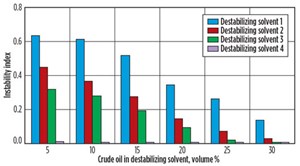
Another method made use of the rotating concentric cylinder or Taylor-Couette system.17 With this testing method, deposition has been measured under both static and flow-through modes of operation. Flow-through tests develop higher deposition amounts through the avoidance of depletion affects. The shear stress also can be adjusted to approximate various line diameters and production rates. While these test methods facilitate pressure-induced asphaltene destabilization, and may be able to gauge potential deposition rates, they are very time-consuming, and require very costly, bottomhole, live crude oil samples for the most accurate results. A benchtop, lab-based method that can measure asphaltene stability in dead-crude oils with the flexibility to shift test conditions close to those encountered in the field and yield reliable, reproducible results would be more desirable.
ASPHALTENE-ACSA METHOD
The Asphaltene-ACSA method for asphaltene stability analysis utilizes an analytical centrifuge, which spins up to 12 samples fixed horizontally on a flat rotor while measuring the transmittance of near-infrared (NIR) light shone through the entire sample length. The analytical centrifuge was designed as a tool to evaluate dispersion stability. By monitoring changes in light transmission along the entire length of a sample during centrifugation, changes in the dispersion’s solid concentration, at various levels of the sample, can be detected. As the dispersed solids scatter light, the light transmission will increase in areas losing solids and decrease—if not already opaque—in areas gaining solids.
As such, sedimentation (solids settling) or creaming (solids rising) can be observed in a relative quantitative manner using analytical centrifuges. As the dispersion breaks down, solids start separating from the carrier fluid and move toward the bottom of the vial. As the solids separate, the transmission of light increases in the top portions of the sample. The transmission increase continues to progress down the length of the sample, as solid settling continues. Correspondingly, at the very bottom of the sample, the transmission can decrease, due to the increase of solids settling at the centrifuge vial bottom.
For the analytical centrifuge used in Asphaltene-ACSA testing, centrifugal force on the sample can be controlled from 5 to 2,300 × g, and temperature can be controlled from 4°C to 60°C; sample size can range from 0.1 to 2 mL. The software provided with the instrument can use the transmittance data generated to calculate the normalized potential for solids flocculation and settling from the sample. This calculation parameter is termed the instability index. The instability index is a calculation of the change in integral transmission between time t and time 0, normalized by the maximum theoretical transmission, resulting in a calculated value from 0 to 1.0. An instability index of 0 indicates a sample is completely stable, with no change in the transmittance trace occurring. In contrast, increased sample instability leads to increased transmittance change, and a larger instability index value.
Similarly in Asphaltene-ACSA testing, asphaltene stability is gauged by monitoring the change in transmittance as the sample is centrifuged during the test. The transmittance of light through crude oil is dependent on the concentration of asphaltenes, which absorb light. As such, the change in transmittance can be used to monitor asphaltene stability by determining changes in asphaltene content in the different regions or entire sample length.
As mentioned previously, a destabilizing solvent is mixed with the crude oil to create asphaltene destabilization. This is done immediately before centrifuging. As asphaltenes are precipitated from the crude oil/destabilizing solvent mixture and settle, the light transmittance through the sample will increase. The greater the amount of asphaltenes destabilized, the larger the magnitude of transmittance increase. Asphaltene-ACSA testing can provide: 1) relative stability comparisons between different crude oils; 2) asphaltene inhibitor efficacy comparison; and 3) indications of asphaltene inhibitor performance variation with varying dosage rates. In evaluating asphaltene inhibitors, the product that can reduce asphaltene destabilization, evidenced by the lowest instability index, provides the best inhibition.
In comparison to the ASTM D7061-04 method, or similar tests, the Asphaltene-ACSA method offers the advantage of centrifugal force to enhance asphaltene settling. The centrifugal force has been found to help better differentiate asphaltene inhibitor performance. In addition, the Asphaltene-ACSA method has the advantage of using much higher crude oil concentrations, due to smaller sample vial path length. The higher crude oil concentrations also help to better distinguish asphaltene inhibitor performance in creating more stringent asphaltene settling conditions. Asphaltene agglomeration, and subsequent settling of larger agglomerate particles, occurs more easily in higher-concentration environments. The ASTM D7061-04 method uses very highly diluted petroleum samples. Greater throughput is also offered with the analytical centrifuge, with the ability to run multiple samples at the same time. In general, the Asphaltene-ACSA method has been found to offer quick, reproducible and more discriminating evaluations of relative crude oil asphaltene stability and asphaltene inhibitor performance.
FIELD CONDITIONS
As mentioned, the amount and fraction of asphaltenes destabilized can be altered with the choice of destabilizing solvent and the solvent/crude oil mixture ratio used. Figure 1 shows how the amount of asphaltenes precipitated can be adjusted by varying the choice of destabilizing solvent, and the solvent/crude oil mixture ratio for a Gulf of Mexico Crude Oil A. The figure shows the destabilized asphaltene content for Crude Oil A as a function of the destabilizing solvent/crude oil mixture ratio for four destabilizing solvents.
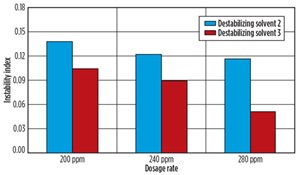
Crude Oil A has a total heptane (destabilizing solvent #1) asphaltene content of approximately 2.6 wt.%. By adjusting the destabilizing solvent and solvent/crude oil mixture ratio, the amount of asphaltenes destabilized can be altered from 0% to 100%. The range that can be used for the Asphaltene-ACSA testing is limited to a slightly smaller band, since it’s dependent on obtaining suitable transmittance through the solvent/crude oil mixture. Depending on the crude oil API gravity, the transmittance at very low solvent ratios may not be sufficient for testing. In addition, sometimes the asphaltene destabilization might need to be increased to obtain differentiation in asphaltene inhibitor evaluation. For example, with extremely slight asphaltene destabilization, excellent performance is often shown with multiple asphaltene inhibitor products at low dosage rates. To achieve performance differentiation, conditions sometimes are modified to induce greater asphaltene destabilization.
In Fig. 1, the fractional amount of asphaltenes precipitated from the total ~2.6 wt.% asphaltenes can be determined. Although the exact fractional amount depends on the solvent/crude oil ratio used, some generalizations can be made about the approximate fractional amounts of asphaltene capable of being precipitated, using the different destabilizing solvents. For the solvent/crude oil ratios used in the Asphaltene-ACSA testing, in this article, with Crude Oil A, the approximate, maximum, asphaltene fractional yield range for the different destabilizing solvents is given in Table 1. Actual asphaltene fractional yield will be slightly lower in the Asphaltene-ACSA testing as it is, generally, performed in approximately 10 min., whereas the curves generated in Fig. 1 had ~16 hours for destabilization.
For methods such as ASTM D7061-04, the fractional amount is ~100 wt.%. As such, there is a significant difference in the asphaltene yield, and, as discussed, a corresponding difference in the overall asphaltene chemistry of the fractional distribution. Again, probably more importantly though, is that with using significantly higher crude oil concentrations in the Asphaltene-ACSA method (~5%-40% volume), more destabilized asphaltenes can actually be generated in samples, despite significantly reducing the fraction of asphaltenes destabilized in comparison to methods, such as ASTM D7061-04.
TEST RESULTS
Effect of destabilizing solvent /crude oil ratio. Figure 2 shows Asphaltene-ACSA tests with Crude Oil A, using heptane as the destabilizing solvent. The tests were run at 5.3 × g centrifugal force over 10 min. (600 sec) with transmittance scans logged every 20 sec. The crude oil contents ranged from 5% to 30% volume (70% to 95% heptane). Figure 2 shows the transmittance traces from the top to the bottom of the centrifuge vials for each sample over the test period.
Figure 2 shows the transmittance increase, progressing from the upper regions of the centrifuge vial toward the bottom, as asphaltenes precipitate and settle to the bottom of the vial over time. Correspondingly, at the very bottom of the vial, transmittance decreases where the destabilized asphaltenes settle. In the tests with the higher destabilizing solvent/crude oil mixture ratios, greater increases in transmittance are observed, as greater amounts of asphaltenes are destabilized. For example, the final average transmittance of the 5% crude oil test is ~80%, whereas, the final average transmittance of the 30% crude oil test is only ~15%.
All destabilizing solvent to crude oil ratios used in Fig. 2 result in a sufficient amount of destabilized asphaltenes to create a significant change in transmittance, in the crude oil/solvent mixtures. If no—or very little—asphaltenes are destabilized, then minimal change in transmittance will be observed, and the instability index will be approximately zero. In some cases, having very slight changes might be closer to actual field conditions, but these are not necessarily ideal testing conditions to differentiate asphaltene inhibitor performance. Adding additional stress to the system, and inducing greater asphaltene destabilization, is sometimes useful for asphaltene inhibitor testing. Running testing over a range of destabilizing conditions is a useful first step for planning testing programs.
Effect of destabilizing solvent. As mentioned previously, another means to alter asphaltene precipitation is to change the destabilization solvent. Figure 3 shows the change in instability index values in the Asphaltene-ACSA tests with Crude Oil A using Destabilizing Solvents 1, 2, 3 and 4. The tests were performed using different destabilizing solvent/crude oil ratios—concentrations ranging from 5% to 30% crude oil. The instability index values decrease both as the crude oil content is increased, and the strength of the destabilizing solvent is decreased. This is related to a reduction in the fractional amount of asphaltene destabilized in these tests. In fact, the tests with the weakest destabilizing solvent (#4) exhibited only very small instability index values at all destabilizing solvent/crude oil ratios. Recall, destabilizing solvent #4 will only precipitate a maximum of approximately 15% to 25% of the asphaltenes in Crude Oil A, based on the (overnight) asphaltene content measurements shown in Fig. 1. In these shorter, 10-min. Asphaltene-ACSA tests, kinetic effects would likely further reduce the fractional amount of destabilized asphaltenes.
EVALUATION OF ASPHALTENE INHIBITORS
Comparison to ASTM D7061-04 type testing. A standard analytical technique available for measuring the stability of the foulants, before and after treatment with foulant inhibitors, is the ASTM D7061-04 method, or slight variations thereof. These methods utilize an optic scanning device analyzer, where a NIR light source is passed through a sample tube containing a mixture of crude oil and heptane. The parameters of the ASTM D7061-04 type method for crude oil asphaltene stability analysis, typically, include using a crude oil concentration of 1% to 5% (95% to 99% heptane). The maximum recommended petroleum concentration in the official ASTM D7061-04 method is 2.67%. The total sample volume is 5 to 8 mL. The path length of the sample tube is about 12 mm, which directly corresponds to the need for very low crude oil/high heptane contents.

While some measurement devices can operate at elevated temperatures, the standard method calls for room temperature. No mechanical or external stress, in excess of gravitational force, is added to the fluid sample. Gravitational force is often not sufficient to fully separate precipitated asphaltenes, particularly when testing asphaltene inhibitor-treated crude oils. ASTM D7061-04 type methods can offer a quantitative measure of asphaltene stability by the calculation of a separability number, which is similar, in principal, to the calculation of the instability index used in the Asphaltene-ACSA method.
In comparison to the ASTM D7061-04 type method, the new Asphaltene-ACSA method utilizes a similar NIR transmittance analysis on crude oil/destabilizing solvent mixtures. An important differentiation between the two methods, however, is the addition of centrifugal force. The external force on the crude oil/destabilizing solvent mixture results in a more complete separation of precipitated asphaltenes, and, accordingly, enhanced differentiation between treated samples.
In addition, the use of a very short path length allows for a much higher crude oil/destabilizing solvent volume ratio, which can, again, bring the sample analysis much closer to field-like conditions, as compared to the ASTM D7061-04 method. To highlight the enhanced differentiation between asphaltene inhibitor performance between Asphaltene-ACSA and ASTM D7061-04 type testing, comparisons between quantified instability values from the two methods are presented in Table 2 for a Gulf of Mexico Crude Oil B treated with a range of dosages of an asphaltene inhibitor. The change in the dose rate is very slight, ranging from 200 ppm, 240 ppm and 280 ppm of the asphaltene inhibitor.
No differentiation can be observed in the ASTM D7061-04 type tests, between the different dosages of asphaltene inhibitor. In fact, the testing indicates that practically no destabilization is occurring in each of the treated samples. The Asphaltene-ACSA testing shows that although the asphaltene inhibitor greatly improves asphaltene stability, some small amount of instability still exists in each sample. It also shows that a consistent increase in stability is obtained with increasing the dose rate of the asphaltene inhibitor from 200 ppm to 280 ppm.
Figure 4 shows similar testing with Crude Oil A also treated with 200 ppm, 240 ppm and 280 ppm of asphaltene inhibitor. In this case, the testing is with destabilizing solvents #2 and #3, which destabilize fewer asphaltenes. Again, the Asphaltene-ACSA testing is able to differentiate performance differences, with the small dosage rate changes with the reduced level of destabilized asphaltenes.
Figure 4 and Table 2 are good examples which indicate how the asphaltene-ACSA method could, potentially, be used for field monitoring programs. The ability to detect small changes in asphaltene stability could be used for: 1) monitoring squeeze programs to estimate asphaltene inhibitor concentrations in production returns; 2) monitoring effects from changing production; 3) monitoring effects from changing inhibitor injection; and 4) potential influences from recent field operations changes.
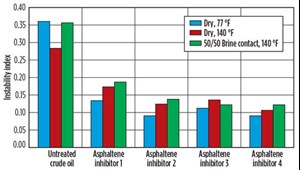
To further illustrate Asphaltene-ACSA testing’s ability to distinguish fine asphaltene inhibitor performance differences, Fig. 5 shows a comparison of Asphaltene-ACSA results of Crude Oil A treated with three different asphaltene inhibitors. In this example, the same inhibitor dosage was used, so the performance differences are due to different product chemistries.
All three asphaltene inhibitors provide some reduction in instability index over the untreated crude oil, ranging from a 28% to a 93% reduction. From the testing, it is evident that asphaltene inhibitors #2 and #3 perform significantly better than #1. More interestingly, illustrated in the figure is the ability to determine performance differences between inhibitors #2 and #3. Inhibitor #2 has a consistent, 6% to 7% better performance in instability index reduction than inhibitor #3 in both destabilizing solvent #2 and #3 tests. This is typical of the ability of the Asphaltene-ACSA testing to distinguish differences in inhibitor performance.
The ability to distinguish small changes in asphaltene stability allows the influence of other factors, which may affect asphaltene stability or asphaltene inhibitor performance, to be examined. For example, the effects of elevated temperatures and potential influences of other production fluids or contaminates can be evaluated. Figure 6 shows the effect of temperature and brine contact on asphaltene inhibitor performance in testing with a Canadian Crude Oil C. Shown is testing with different inhibitors at room temperature, at 140°F, and at 140°F with brine contact. In this example, it can be seen that the asphaltene inhibitors’ performance decreased slightly with increasing temperature.
Perhaps more importantly, from this example, it can be seen at times that different conclusions might be obtained, if other influences are included in evaluations. In Fig. 6, when including the higher temperature/higher temperature brine contact testing, it can be concluded that asphaltene inhibitor #4 is the better product for treatment. Whereas, if only the 77°F room temperature data were evaluated, asphaltene inhibitor #2 would be chosen. In this case, the performance differences between asphaltene inhibitors #2 and #4 are only slight. However, in other systems, more significant differences might be uncovered. ![]()
CONCLUSIONS
This article has reviewed some asphaltene screening methods and presented a new asphaltene stability analysis method, using an analytical centrifuge coupled with a destabilizing procedure. This moves test conditions closer to field conditions than some other dead crude oil methods.
ACKNOWLEDGEMENTS
This article is an adaptation of SPE paper 170677-MS.
REFERENCES
- Institute of Petroleum, “Standards for petroleum and its products,” IP 143/90, London, UK, 1985.
- Klein, G.C., S. Kim, R.P. Rodgers, A.G. Marshall, A. Yen and S. Asomaning, “Mass spectral analysis of asphaltenes. I. Compositional differences between pressure-drop and solvent-drop asphaltenes determined by electrospray ionization fourier transform ion cyclotron resonance mass spectrometry,” Energy & Fuels, 20, 1965-1972, 2006.
- Klein, G.C., S. Kim, R.P. Rodgers, A.G. Marshall and A. Yen, “Mass spectral analysis of asphaltenes. II. Detailed compositional comparison of asphaltene deposits to its crude oil counterpart for two geographically different crude oils by ESI FT-ICR MS,” Energy & Fuels, 20, 1973-1979, 2006.
- Nagarajan, N.R., M. Stratton, P. Juyal, A. Yen and J. Nighswander, “Asphaltene issues and challenges in the Gulf of Mexico: Current technology gaps and the path forward,” paper presented at the 14th International Conference on Petroleum Phase Behavior and Fouling, Rueil-Malmaison, France, June 10-13, 2013.
- Wiehe, I.A., “Laboratory solvent deasphalting with a wider range of liquids,” Process Chemistry of Petroleum Macromolecules, CRC Press, Chapter 7.3, 2008.
- Jennings, D.W., and I.A. Wiehe, “Physical and chemical properties of deasphalted oil and asphaltenes from laboratory deasphalting experiments on Alberta bitumen,” Poster presented at the 9th International Conference on Petroleum Phase Behavior and Fouling, Victoria, British Columbia, June 16-19, 2008.
- Fotland, P., H. Anfindsen, and F.H. Fadnes, “Detection of asphaltene precipitation and amounts precipitated by measurement of electrical conductivity,” Fluid Phase Equilibria, 82, 157-164, 1993.
- Carrier, H. and S. Verdier, “Study of pressure and temperature effects on asphaltene stability in presence of CO2,” Energy & Fuels, 20, 1584-1590, 2006.
- Jammaludin, A.K.M., J. Creek, C.S. Kabir, J.D. McFadden, D. D’Cruz, M.T. Joseph, N. Joshi and B. Ross, “A comparison of various laboratory techniques to measure thermodynamic asphaltene instability,” SPE paper 72154, presented at the SPE Asia Pacific Improved Oil Recovery Conference, Kuala Lumpur, Malaysia, Oct. 8-9, 2001.
- Kokal, S., N. Dawood, J. Fontanilla, A. Al-Ghamdi, H. Nasr El-Din and Y. Al-Rufaie, “Productivity decline in oil wells related to asphaltene precipitation,” SPE paper 77767, presented at SPE Annual Technical Conference and Exhibition, Sept. 29–Oct. 2, San Antonio, Texas, 2002.
- Hammami, A.; C.H. Phelps, T. Monger-McClure, and T.M. Little, “Asphaltene precipitation from live oils: An experimental investigation of the onset conditions and reversibility,” paper presented at AIChE Spring National Meeting, March 14–18, Houston, Texas, 1999.
- Hammami, A., and M.A. Raines, “Paraffin deposition from crude oils: Comparison of laboratory results with field data,” SPE J, 4 (1), 9–18, 1999.
- Jamaluddin, A.K.M., A. Sivaraman, D. Imer, F.B. Thomas and D.B. Bennion, “A proactive approach to address solids (wax and asphaltenes) precipitation during hydrocarbon production,” SPE paper 49465, presented at the 8th Abu Dhabi International Petroleum Exhibition and Conference, Abu Dhabi, U.A.E, Oct. 11–14, 1998.
- Karan, K., A. Hammami, M. Flannery and A. Stankiewicz, “Systematic evaluation of asphaltene instability and control during production of live oils: A flow assurance study,” paper presented at AIChE Spring National Meeting, New Orleans, La., March 10–14, 2002.
- Zougari, M., A. Hammami, G. Broze and N. Fuex, “Live oils novel organic solid deposition and control device: Wax deposition validation,” SPE paper 93558, presented at 14th SPE Middle East Oil & Gas Show and Conference, Bahrain, March 12–15, 2005.
- Zougari, M., S. Jacobs, J. Ratulowski, A. Hammami, G. Broze, M. Flannery, A. Stanliewicz and K. Karan, “A novel organic solid deposition and control device for live oils: Design and application,” Energy & Fuels, 20(4), 1656–1663, 2006.
- Akbarzadeh, K., Z. Huo and G. Broze, “Flow-through tests advance researchers’ understanding of asphaltene deposition,” World Oil, pp. 105–107, February 2010.
- Gonzalez, D.L. “Modelling of asphaltene precipitation and deposition tendency using the PC-SAFT equation of state,” PhD Thesis, Rice University, 2008.
- Wang, J.X., J.S. Buckley, N.E. Burke and J.L. Creek, “A practical method for anticipating asphaltene problems,” SPE Production & Facilities, pp. 152–160, August 2004.
- Kurup, A.S., J. Buckley, J. Wang, H.J. Subramani, J.L. Creek and W.G. Chapman, “Asphaltene deposition tool: Field case application protocol,” paper presented at the Offshore Technology Conference (OTC), Houston, Texas, April 30–May 3, 2012.
- Asomaning, S., “Test methods for determing asphaltene stability in crude oils,” Petroleum Science and Technology, Vol. 21 (3&4), 581-590, 2003.
- ASTM Standard D7061-04. “Standard test method for measuring n-Heptane-induced phase separation of asphaltene-containing heavy fuel oils as separability number by an optical scanning device,” ASTM International, West Conshohocken, PA, D02.14, www.astm.org, 2004.
- Wang, J.X., J.S. Buckley and J.L. Creek, “Asphaltene deposition on metallic surfaces,” J. Disp. Sci. Tech, 25, 287-298, 2004.
- Carmichael, J., and D. Fouchard, “New method for the assessment of asphaltene deposition behavior,” presentation at the 15th International Conference on Petroleum Phase Behavior and Fouling, Galveston, Texas, June 8–12, 2014.
- Asomaning, S., C.T. Gallagher and P.J. Breen, “Stability of asphaltenes in comingled live crude oils: Implications for subsea systems,” paper presented at AIChE Spring National Meeting, Atlanta, Ga., March 8, 2000.
- Advancing offshore decarbonization through electrification of FPSOs (March 2024)
- What's new in production (February 2024)
- Subsea technology- Corrosion monitoring: From failure to success (February 2024)
- U.S. operators reduce activity as crude prices plunge (February 2024)
- U.S. producing gas wells increase despite low prices (February 2024)
- U.S. oil and natural gas production hits record highs (February 2024)
- Applying ultra-deep LWD resistivity technology successfully in a SAGD operation (May 2019)
- Adoption of wireless intelligent completions advances (May 2019)
- Majors double down as takeaway crunch eases (April 2019)
- What’s new in well logging and formation evaluation (April 2019)
- Qualification of a 20,000-psi subsea BOP: A collaborative approach (February 2019)
- ConocoPhillips’ Greg Leveille sees rapid trajectory of technical advancement continuing (February 2019)

